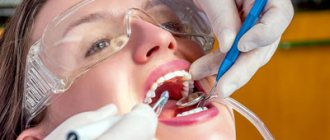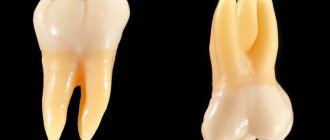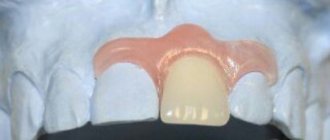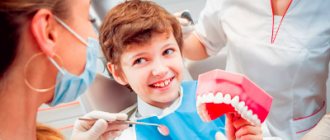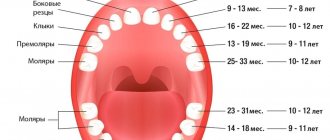Various anomalies in the growth and development of teeth can become a serious challenge for a person. Such pathological processes not only worsen the aesthetics of the smile and facial proportions, but can also cause a number of serious complications. Malocclusion, the development of inflammatory processes, aching pain, difficulties with chewing food - these are the main, but not the only consequences of improper tooth growth.
The most common problems in dentistry are retention and dystopia of teeth. Why are such pathologies dangerous and how to recognize them correctly?
More about tooth impaction
Tooth retention is an anomaly in which the crown does not erupt and remains under the mucous membrane. It is accompanied by painful sensations that increase with palpation, as well as redness and swelling of the gums in the area of the impacted tooth.
The pathology is most typical for wisdom teeth, which often do not have enough space to erupt. Retention of canines, lateral and central incisors is less common.
There are complete and partial recessions:
- full - the crown is completely hidden under the gum and may be located in the bone tissue of the jaw;
- partial – a small part of the crown is visible when examined using special dental instruments.
Retention is a rather dangerous problem that can lead to the formation of cysts, resorption of the roots of adjacent teeth, as well as chronic periodontal inflammation.
Tooth impaction: main causes
- — infectious processes in the oral cavity;
- - too thick layer of dental sac, which prevents teething;
- — delays in the change of temporary bite to permanent;
- — presence of rudiments of supernumerary (extra) crowns;
- - some serious diseases in the body;
- - improper artificial feeding of the child.
Dystopic wisdom tooth: what is it?
A dystopic wisdom tooth is a third molar, also known as a “figure eight”, which is positioned incorrectly relative to the rest of the dentition. Such a tooth almost always needs to be removed.
A special case of a dystopic wisdom tooth is an unerupted, but fully formed figure eight, which turns out to be turned parallel to the gum. In this case, the tooth is there, although it is not visible, and it is in an incorrect position, so we can talk about dystopia.
Two examples of dental dystopia
Causes of dystopic wisdom teeth
Very often, dental dystopia is associated with genetic reasons. A predisposition to shifting dentition is inherited along with small jaw size and other aspects of individual appearance that can cause teeth to shift. Doctors call other factors that provoke improper growth of molars, incisors and fangs:
- atypical formation of the tooth germ in the embryonic period;
- macrodentia, partial adentia, supernumerary teeth and other diseases;
- improper eruption (can be caused by early removal of the primary bite);
- small jaw size;
- mechanical damage, dental trauma;
- bad habits such as chewing foreign objects, thumb sucking (affect the development of malocclusion);
- late eruption of canines, for which there is no longer room in the dentition.
Modern dentistry successfully cures the patient, regardless of the causes of tooth dystopia and its position in the gum. The main thing is to seek help in time.
Reasons for development
The causes of such a phenomenon as dystopia can be genetic diseases, embryonic, hereditary, and external factors :
- a genetic disease due to which the child has an underdeveloped jaw and at the same time large teeth;
- deviation during embryonic development, which leads to improper formation of primordia;
- development of teeth beyond normal;
- the formation of molars ahead of schedule or their uneven appearance;
- bad habits (sucking a pacifier or finger for a long time), various bruises, injuries to the oral mucosa;
If the fangs do not appear until the age of 9-12, then there is no place for them and as a result they take someone else’s place and a problem naturally arises.
“Eights” can be dystopic due to the fact that they do not have predecessors in the primary occlusion and they have to independently make their way through the bone tissue.
Types of wisdom teeth dystopia
Wisdom tooth dystopia is classified depending on which direction the crown is shifted. The following types of disease are distinguished:
- vestibular (forward displacement);
- oral (teeth located behind the entire row);
- mesial (forward bend);
- distal (backward tilt);
- with supraposition (above the dentition);
- with infraposition (below the dentition);
- with tortoposition (the tooth is rotated around its axis);
- with transposition (the tooth is in the place of another tooth).
In the most severe cases, you can observe the appearance of a tooth outside the oral cavity: for example, inside the nose. This is very dangerous and requires immediate treatment.
How to avoid complications
Severe swelling may occur for 2-3 days. This is a normal phenomenon that gradually goes away. If everything went well, within a week there will be no trace of swelling left.
It is not uncommon for the wound to bleed for some time. To stop it, special medications are placed in the hole. To avoid adverse reactions, doctors advise to temporarily avoid solid, tough foods, as well as cold or hot foods. Daily hygiene should be gentle but effective.
In what cases should you immediately contact a dental clinic:
- persistent bleeding;
- severe swelling of the soft tissues, which does not decrease, numbness of the face;
- discomfort when opening the mouth;
- the appearance of an inflammatory process;
- violation of the integrity of neighboring healthy units and gums.
Symptoms of dystopia
Symptoms of dental dystopia are most often visual and easily noticeable. It is enough to look at the position of all the elements of the dentition to see that some of them are in the wrong places or are simply growing unevenly. Other symptoms:
- there is no tooth in the bite, and the period of eruption has already passed;
- inflammation and pain are felt at the site of the wisdom tooth;
- The wisdom tooth did not appear on time
It is interesting that in a number of cases there is no wisdom tooth at all - it does not form and does not erupt. Dentists call this option a variation of the norm.
Preventive measures
Dentists at the Optimal Choice clinic give their patients the following recommendations, compliance with which helps reduce the risk of complications in the postoperative period:
- after completion of the operation, you must abstain from food for at least three hours;
- hot and cold food and drinks are contraindicated. To quench your thirst, plain water at room temperature is suitable;
- physical activity should be reduced to a minimum,
- you need to give up solid foods and not use a toothbrush with hard bristles;
- You cannot take a hot bath or shower, visit a bathhouse or sauna, and hot compresses are also contraindicated;
- You cannot smoke after surgery for at least three hours;
- you need to give up alcohol for several days;
- mouth rinses, active ones at that, are contraindicated;
- You can use oral baths: take a medicinal solution or herbal decoction at a comfortable temperature into your mouth, hold it for several minutes and spit it out;
- Five-minute cold compresses can be used to relieve swelling and reduce pain;
- take all medications prescribed by your doctor;
- come for a follow-up appointment on the appointed day.
If the bleeding does not stop for a long time, the pain does not go away even after taking painkillers, or other alarming symptoms occur, you should urgently visit your doctor.
Consequences of dystopia
Although dental dystopia does not seem like a terrible disease, it can create many problems. This is why wisdom teeth that have grown incorrectly are most often removed. Among the most unpleasant consequences of the disease:
- disruption of the entire dentition, because due to one incorrect element, the rest move or cannot erupt correctly;
- injury to the tissues of the cheeks, tongue, lips, which can cause ulcers and even provoke the development of tumors;
- complication of oral hygiene, which leads to inflammation, caries, both on the dystopic and adjacent teeth;
- the appearance of gingival pockets where bacteria accumulate, leading to pericoronitis;
- impaired chewing function, which in turn reduces the quality of food and can lead to deterioration of the gastrointestinal tract;
- difficulty pronouncing words, poor diction;
- violation of the facial skeleton, unaesthetic appearance of the lower part of the face.
Almost always, dystopia leads to unpleasant aesthetic consequences, which causes complexes and rejection of one’s appearance in the child, and then in the adult. Of course, this can be worked out with a psychologist, but it is much wiser and more correct to deal with the cause than to deal with the consequences.
Diagnosis of dystopia
An orthodontist or even a dental therapist can easily determine tooth dystopia during a routine examination if the anomaly is not complex. In some cases, when an element of the dentition remains in the gum, ends up in the palate or another place, during the examination one can only suspect a problem.
If the doctor has not found one of the teeth that should have already erupted in a child (or an adult, if we are talking about eights), he will refer the patient for an x-ray examination. The picture clearly shows all the irregularities and you can see the formed teeth in the soft tissues. To clarify the position and for subsequent treatment, arthopantomography, creation of plaster models of the jaws, and teleradiography are used.
Why does retention occur?
There are several reasons for this phenomenon:
- Lack of free space due to incorrect alignment of adjacent teeth.
- Supernumerary of the jaw.
- Inflammation or premature removal of baby teeth.
- Improper functioning of the glands that are responsible for internal secretion.
- Incorrect placement of the permanent tooth germ.
- Genetic predisposition, when disturbances in the formation of molars are transmitted hereditarily.
- The absence of neighboring teeth, which determine the correct shape of the dentition.
When is the best time to treat dental dystopia?
Like any dental disorder, dystopia should be treated immediately after the problem is discovered. The easiest time to change the position of teeth is during childhood and adolescence (up to about 18 years of age). This is due to the time of formation of the jaw bones. Until adulthood, the bone is still quite soft, which makes it easy to align the bite.
Sometimes, although rarely, trainers are used to treat dystopia. Read more about them in the article: Trainers for teeth straightening: description, varieties, tips for use
If we are talking about dystopic molars , then they are almost always removed. The third molars themselves are considered an atavism and an optional element in the dentition; moreover, their treatment is associated with problems and difficulties. Therefore, doctors do not try to save these teeth.
Sometimes treatment is associated not with removal, but with grinding of the tooth. This decision is made if the dystopic element does not interfere with the chewing function and does not violate the aesthetics of the oral cavity. In this case, it is recommended to be constantly monitored by a doctor, since such elements of the dentition are easily affected by caries. Moreover, the consequences are much more serious than in ordinary cases: incorrect tooth position stimulates the development of bacteria, inflammation, and complications.
Installation of braces for the treatment of canine dystopia
Why does pathology develop?
When conducting numerous medical studies, it was found that there is a list of provoking factors that lead to dystopia. The process of formation, growth and development of dental units in the fetus is affected by gynecological diseases of a woman during pregnancy. For example, this includes toxicosis in the 1st trimester of pregnancy and iron deficiency anemia. In addition, infectious processes (not only in the genitals) and bad habits (smoking, alcohol abuse) in the expectant mother are extremely dangerous.
Dystopic incisors, canines and molars may have irregular shapes and abnormal sizes. The likelihood of retention, supernumerary, and adentia increases.
All reasons are divided into 3 large groups:
- Intrauterine. These are infections, metabolic disorders, rickets, lack of vitamins, problems with the thyroid gland, etc.
- Phylogenetic. This includes changes associated with evolutionary transformations of the dental system. Since the jaws become smaller over time and the row structure does not change, there is little room for new units to develop properly.
- Local factors.
The last category includes many external and internal reasons, such as:
- infection of the rudiments of permanent occlusion with periodontitis of bone elements in the milk;
- delayed eruption in the first year of life;
- fusion of root parts located nearby;
- premature loss in preschool children;
- mechanical impact;
- cementomas (slow-growing tumors resembling cement);
- too deep placement of the follicle in the jaw;
- formation of follicular cystic neoplasms;
- tumors that displace unerupted buds.
Removal of dystopic wisdom tooth
Removing a dystopic wisdom tooth is a fairly serious operation that requires professionalism and care from the doctor. Incorrect actions can lead to dislocation of adjacent teeth, lower jaw, injury to the mandibular canal and other problems. Therefore, it is very important to contact experienced specialists who are familiar with the specifics of removing complex teeth.
Indications for removing a dystopic tooth
Clear indications for removal:
- detection of a jaw cyst;
- traumatic dystopia;
- diseases of the jaw caused by this tooth;
- difficulties in treating caries in adjacent teeth;
- the appearance of pulpitis and periodontitis.
The practice is that the decision to remove a child is made taking into account all these factors. In an adult, it is more likely to decide whether to keep a tooth or not – removal is considered a universal solution, the simplest and safest. They resort to it in almost all cases.
Stages of removing a dystopic wisdom tooth
The removal operation is carried out in several stages. Compliance with technology allows you to protect the patient and simplify the operation for the doctor. Also, before starting work, detailed studies must be carried out: a full x-ray of the jaw is taken, all available caries is cured, etc.
During tooth extraction, the surgeon performs the following actions:
- Introduction of anesthetic. This may be local anesthesia or general anesthesia if several teeth are to be removed at once.
- Complete exposure of the tooth. To do this, a flap of mucous membrane and periosteum are peeled off.
- I sawed off the walls using a drill. This is necessary to align the element and make it easier to remove.
- Tooth extraction. The entire molar is removed using forceps. If the tooth was previously destroyed, its fragments are removed. It is important that the doctor removes all the fragments, otherwise inflammation will occur.
- Application of antiseptics to prevent the development of wound infection.
- Returning the mucosal flap to its place.
- Applying seams.
Once the wound is stitched, the operation is over, but the treatment is not. After a week, you should definitely see a doctor to have the stitches removed. It is also advisable to be observed by a specialist for 1-2 months to make sure that the removal had no consequences.
Removal of a dystopic tooth in pictures
Forecast of dystopia
The appearance of a dystopic tooth in a child is not such a serious problem (especially if there is only one). Before a person’s facial skeleton stops growing, the position of the main teeth can be normalized quite quickly. Therefore, it is recommended to begin treatment immediately after identifying the problem. In this case, all the teeth will most likely fall into place and in the future, in adulthood, will no longer cause concern.
If correction of dystopia in an adult is required, this almost always causes many difficulties. After 18-20 years, teeth are no longer so mobile, so correcting their position requires many preparatory interventions. It is much easier to remove a problematic tooth than to try to put it back in place.
Being cured in a timely manner, dystopia has virtually no negative impact on a person’s future life. Most often, the correct bite is maintained for a long time and does not require supervision by a doctor.
Prevention of dystopia
Dentists are confident that if you carefully monitor your child’s dental health from early childhood, you can avoid most bite problems. Dystopic teeth are no exception, because their appearance is not always associated with hereditary factors. To prevent dystopia, doctors recommend the following:
- proper nutrition, adherence to the daily routine of a pregnant mother;
- prevention of jaw injuries from an early age;
- regular visits to the dentist, wearing devices to correct malocclusion;
- giving up bad habits (including weaning off the pacifier after a year and from thumb sucking in sleep), etc.
If you and your child regularly visit a dentist, he will give recommendations on what exactly to do in your case.
Therapy
Treatment for dystopia may be different in each case. Consider your options.
If a wisdom tooth is found to be dystopic, and when chewed it is of less value, then dentists, as a rule, recommend an extraction procedure. Its extraction is especially indicated if the “eight” injures the neighboring one.
It is important to know that the removal of a dystopic tooth can lead to complications, such as dislocation of an adjacent premolar, jaw dislocation, and bleeding.
Teeth must be removed in the presence of pulpitis, periodontitis, cysts, or periostitis . Sometimes the procedure can only take place in a hospital, since this requires a full-fledged surgical intervention with further rehabilitation of the patient.
When there is enough space in the dental arch for normal placement, dentists use braces as a treatment. If the position of the canine is incorrect, most often they try to save it, since it is involved in chewing activities.
The adjacent premolar is removed to make room for the canine tooth. Treatment with braces takes the longest, as retainers will subsequently be required. This is necessary to ensure that the dystopic tooth does not return to its original position.
The stages of treatment are illustrated in the video:
If a tooth is injured, they try to restore it using special splints and wire ligatures. When restoration is not possible, removal is performed, and then prosthetics or implantation.
If the tooth does not provoke any functional problem and does not cause discomfort, then the procedure of grinding sharp cusps is sufficient.
Conclusions. Expert advice
Dystopia is the incorrect position of a tooth in the jaw: its displacement forward or backward, down or up, as well as rotation around its axis or tilt. The appearance of such an anomaly is associated both with hereditary factors and with bad habits or mechanical damage to the jaw. The sooner dystopia is detected, the easier it is to cure. In adults, the wisdom tooth most often found to be dystopic is the third molar, because there may simply not be enough space in the jaw for it to erupt.
The consequences of such anomalies include general malocclusion, frequent inflammatory diseases, impaired chewing function, and much more. Depending on the complexity of the case, dystopia is treated either by tooth extraction or with the help of braces. If the decision is made to remove it, it is important to carry out the operation carefully and correctly. If treatment is started on time, the prognosis for the disease is positive.
How to normalize the position of dystopic fangs?
When choosing a technique, the orthodontist takes into account the severity and type of pathology, as well as the age of the patient. For children under 12 years of age, the use of specialized removable and non-removable structures is recommended:
- night guards worn at night;
- easy-to-maintain soft dental plates designed for long-term wear;
- trainers that target dentofacial defects.
The sooner the correction begins, the faster it will be possible to straighten teeth that are not yet fully formed. On average, the process takes 4–6 months.
Adolescents and adult patients need treatment with braces, which in severe cases will have to be worn for about two years.
